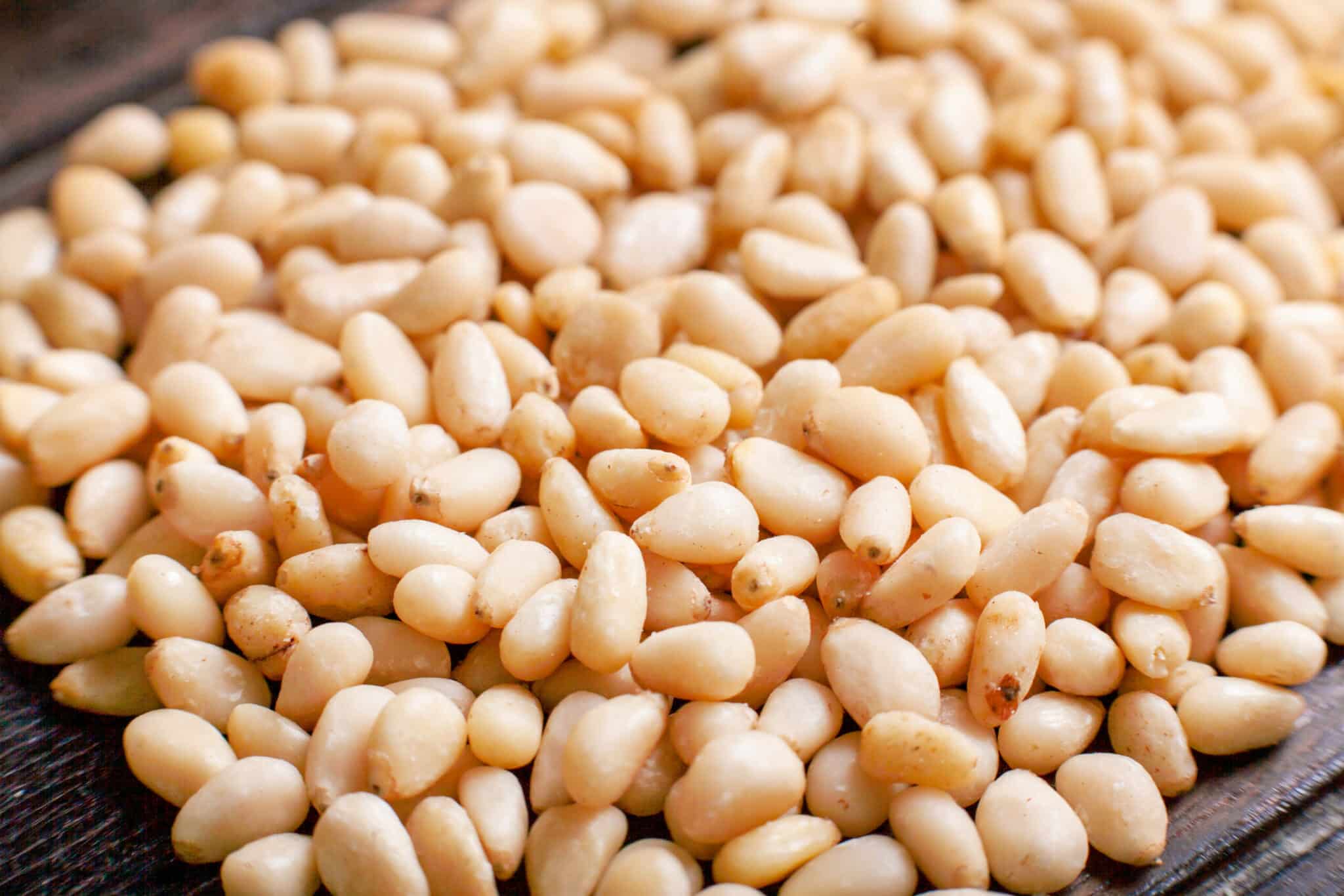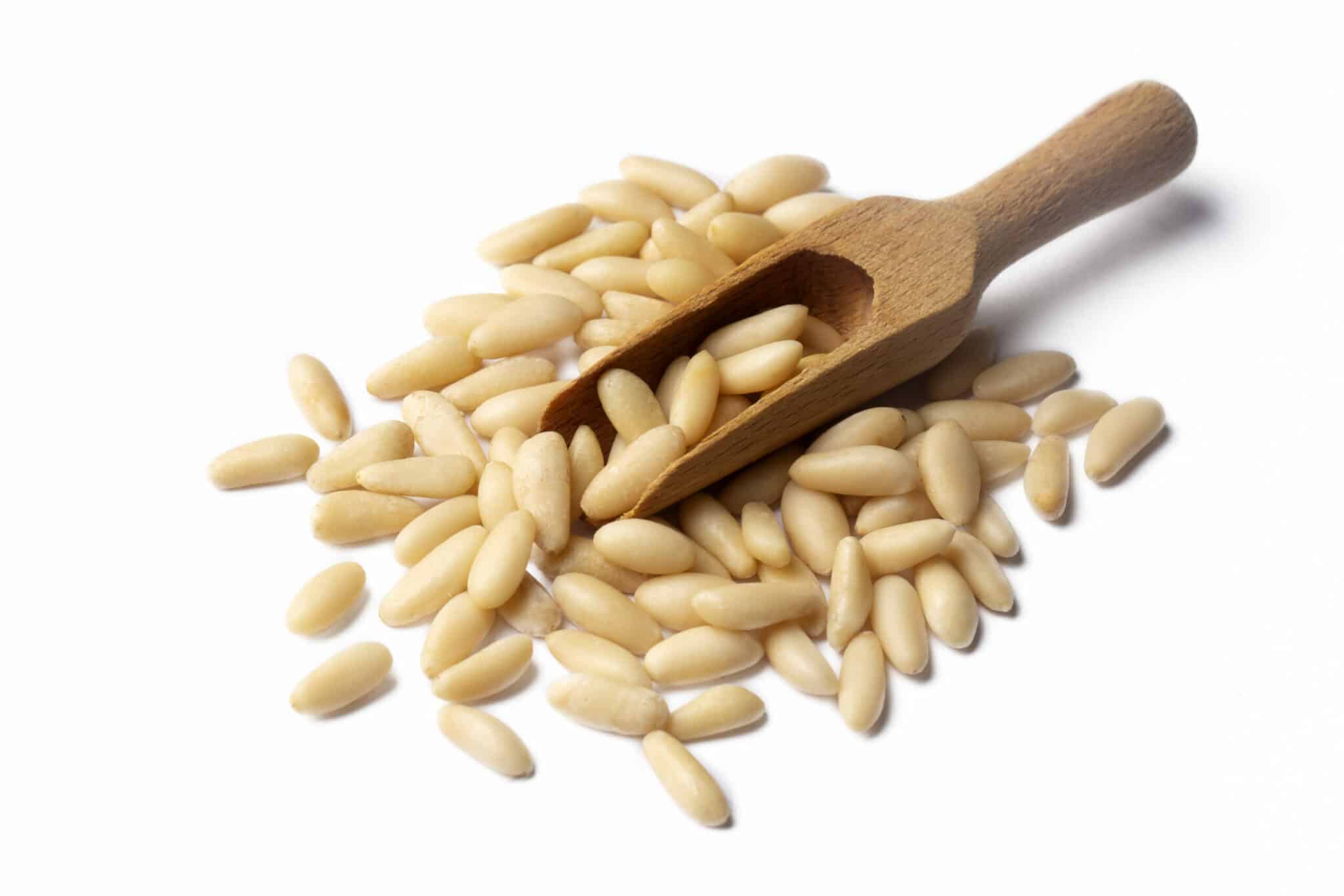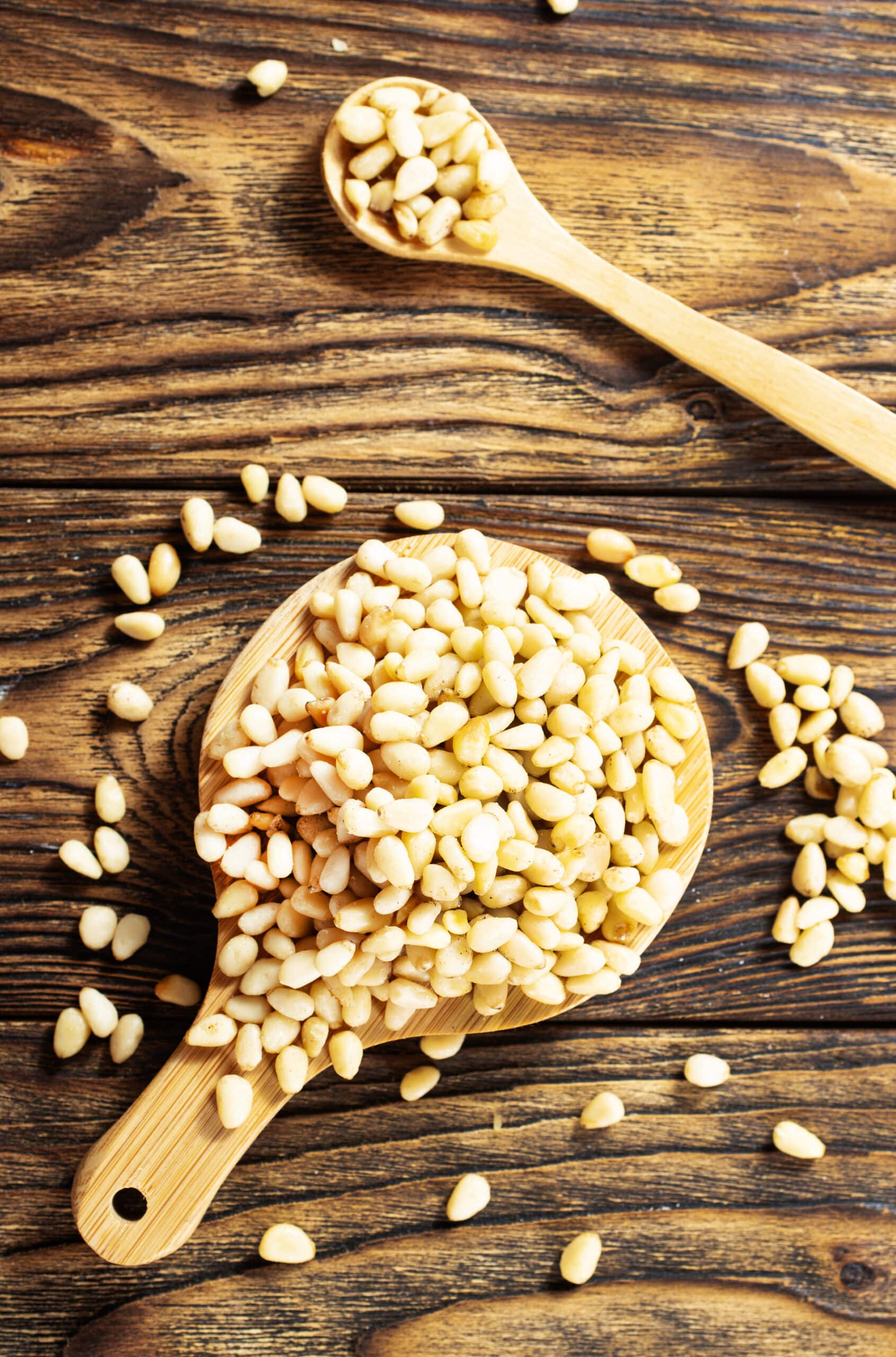Updated on November 9th, 2022
Pine nuts can be eaten raw, but toast them for a somewhat nutty flavor if you’re concerned about a metallic aftertaste. On the other hand, Pine nuts can readily burn or scorch due to their small size and oil content. That is why you should smell them first before purchasing. If you decide to eat them, keep them in a well-sealed container. These nutty beauties are rich in oil and buttery texture with a faint yet unmistakable pine flavor. Because of their high oil content, they’re perfect for pasta, pestos, charcuterie boards, and biscotti.

What does it taste like to eat pine nuts? Pine nuts have a high oil content, giving them a buttery feel. You might discern a slightly resinous pine-like flavor if you crunch a couple on their own. Their flavor becomes milder and sweeter when combined with other components.
What are Pine Nuts?
Pine nuts are edible pine seeds, also known as pión, pinole, pignoli, or chilgoza. Only 29 species provide edible nuts, according to the Food and Agriculture Organization, while 20 are traded locally or internationally due to their seed size being large enough to be worth harvesting; the seeds of other pines are edible as well but are too small to be of significant value as human food.
Pine nuts are gathered from the cones of evergreen trees, though most garden kinds produce nuts that are too little to be worth anyone’s time. The seeds grow beneath the pine cone’s scales and need three years to mature. Harvested ripe nut-bearing cones are dried and then winnowed to remove the nuts. Once they reach bulk bins and retail shelves, this time-consuming and labor-intensive process at least accounts for their high ticket price.
These buttery almonds are most typically used to make pesto sauce in Italian cooking. All pine nuts have a tear-drop shape and a pale yellow-white tint, though certain species, such as European pine nuts, are more elongated than others.
What do Pine Nuts Taste Like?
Pine nuts, like cashews, have a smooth, nutty flavor with a sweet undercurrent. A bitter flavor could indicate that the natural oils in pine nuts have gone rancid, which can happen if they’re kept in the cupboard for too long after they’ve been opened. To avoid extending the shelf life of pine nuts, store them in the freezer.
This ambidextrous nut works well in both savory and sweet dishes. Pesto is made from pine nuts, which are a traditional ingredient. Try scattering them on salads, tossing them with pasta and pilafs, or folding them into wilted greens for a quick side dish. Pine nuts can be ground into cookies, used in biscotti, or added to cakes on the sweet side.
Pine nuts can be eaten raw, but toasting them brings forth their full flavor. Keep a watchful check on them as they toast since they can easily scorch and burn due to their small size and high oil content. They can go rancid quickly due to their high oil content. If possible, smell your pine nuts before purchasing them, and then keep them in a well-sealed container in the fridge or freezer.
Pine mouth, unfortunately, is no laughing matter. For a few days to a few weeks, this abnormal condition induced by eating particular batches of pine nuts makes everything you eat taste bitter or soapy. The specific cause is unknown, and there is no way to tell if a batch is defective. Unfortunately, it’s just the luck of the draw.
What is the Origin of Pine Nuts?
Pine nuts are harvested from trees all around the world. There are around 20 different pine tree kinds with large enough seeds to harvest.
Mexican pinyon (Pinus cembroides), Colorado pinion (Pinus edulis), Italian or Mediterranean stone pine (Pinus pinea), and Chinese nut pine (Pinus armandii) are the four most prevalent, although there are also Siberian and Korean pines. After Russia, Mongolia, China, and Korea, Afghanistan is one of the world’s major exporters of pine nuts.
There are even rules governing the gathering of pine nuts in the United States, and treaties in Nevada grant exclusive harvesting rights to specific Native American tribes. The term “pion” is only used in New Mexico to refer to native pine species.
Health Benefits of Pine Nuts
- One of the calorie-dense edible nuts is pine nuts, and 673 calories are contained in 100 g of dry kernels. They also include a variety of phytochemicals, vitamins, antioxidants, and minerals beneficial to one’s health.
- Fats account for the majority of their high caloric content. Indeed, nuts are high in monounsaturated fatty acids such as oleic acid (18:1 undifferentiated fat), which helps to lower LDL (bad cholesterol) and raise HDL (good cholesterol) levels in the blood. According to research, a Mediterranean diet rich in monounsaturated fatty acids, vitamins, and antioxidants helps avoid coronary artery disease and strokes by promoting a healthy blood lipid profile.
- Pinolenic acid is an essential fatty acid (omega-6 fat) found in pine and cedar nuts. A recent study has indicated that it has the potential to help people lose weight by suppressing their appetite. The hunger-suppressing enzymes cholecystokinin and Glucagon-like peptide-1 (GLP-1) are released in the gut when pinolenic acid is consumed. Pinolenic acid is also suggested to reduce LDL levels via increasing hepatic LDL absorption.
- Pines, like almonds, are a good source of vitamin E, containing about 9.33 mg per 100 g. (about 62% of RDA). Vitamin E is a potent lipid-soluble antioxidant that protects the mucosa and skin cell membrane from damaging free oxygen radicals, ensuring integrity.
- Pines are also one of the gluten-free tree nuts, making them a common element in the manufacture of gluten-free food formulae. Such formula formulations can be a nutritious alternative for persons with dietary wheat allergy or celiac disease.
- Pine nuts are high in the B-complex vitamins, including thiamin, riboflavin, niacin, pantothenic acid, vitamin B-6 (pyridoxine), and folates. These vitamins serve as cofactors for enzymes involved in cellular substrate metabolism.
- Pine nuts also contain important elements such as manganese, potassium, calcium, iron, magnesium, zinc, and selenium at inadequate levels. Pines are one of the richest sources of manganese, with 8.802 mg per 100 g (about 383 percent of the required consumption). Manganese is an essential cofactor for superoxide dismutase, an antioxidant enzyme. As a result, eating pine kernels aids the human body in developing resistance to pathogenic agents and scavenging damaging oxygen-free radicals.
5 Ways to Use Pine Nuts
Pine nuts’ buttery, sweet flavor lends itself to a variety of preparations:
- Pesto Sauce: Pine nuts are most commonly recognized for enhancing pesto sauce. Pine nuts impart a mild nuttiness and rich, creamy texture when paired with fresh, spicy basil, grassy olive oil, and garlic.
- Salads: Pine nuts are naturally oily, so toasting them is easy to amplify their taste for a more distinctive bite in salads. Pine nuts add a softer bite to salads than almonds.
- Dips: Toasted pine nuts are an excellent garnish for an assortment of tasty dips, and they may also be used for hummus or white bean dip for extra texture.
- Desserts: Pine nuts’ soft texture and warm, nutty flavor make them an excellent addition to delicate, buttery pie crusts, particularly when paired with a rich filling, as in Chef Thomas Keller’s lemon sabayon tart with a pine nut pastry crust.
- Coffee: In the southern United States, pine nuts or pine nut oil are used to prepare pión or coffee laced with pine nuts.

How do Pine Nuts get Picked?
It takes roughly 25 years for pine trees to start producing edible seeds and much longer to sustain constant production, and the bulk of pine nuts are collected by hand. Pine nuts are extremely labor-intensive to harvest, reflected in their high price.
The pine cone contains pine nuts: each pine cone scale has roughly two pine kernels. To make prying the seeds from the more closely packed cones easier, they are placed in a burlap sack and dried out in the sun for a little under a month to entice the scales. Each cone’s seeds are then manually extracted.
Shelling is the last step in the harvesting process: Each pine nut, like pistachios, is encased in an outer shell that must be removed.
What has a Flavour that is Comparable to Pine Nuts?
Cashews are a versatile nut that can be used in place of pine nuts in virtually any recipe due to their similar appearance, consistency, and mild sweetness. Stick to unsalted versions (varieties that have been roasted or raw both work), and toast them for an additional layer of flavor depth. These nuts have a stronger flavor and are slightly sweeter than others, making them a suitable overall substitute.
Is it Safe to Eat Raw Pine Nuts?
Because of their rich, buttery flavor, pine nuts are a prominent ingredient in pesto. They can also be included in a wide variety of meals. Raw, they have a delectable flavor and are convenient enough to eat on the go as a snack. You can roast pine nuts by baking them in the oven or toasting them on the stove, and either method will produce the same roasted pine nuts.
Do Pine Nuts have a Bitter Taste?
Consuming pine nuts may, on occasion, result in certain individuals experiencing a bitter or metallic taste that can persist anywhere from a few days up to two weeks. The term “pine mouth” or “pine nut syndrome” has been used to refer to this impairment in taste. Pine nuts aren’t mess up everyone’s taste buds, even if they eat much of them.
In a Recipe, What can be Used Instead of Pine Nuts?
What are the finest alternatives to pine nuts? Toasted and chopped cashews. The flavor of cashews is mildly sweet, and their consistency is similar to that of pine nuts due to their flexible nature. Reduce them to bits roughly the size of pine nuts and are about 1/2-inch long pieces.
Conclusion
When eating pine nuts, some people get a metallic aftertaste. Pine’s mouth is a disorder that affects roughly one out of every thousand persons, and the oil in pine nuts is to blame. Although pine nuts have a pleasant flavor, some people find that they have a bitter aftertaste. However, the condition is not common because some people are unaware of it. The symptoms will normally go away after a few days, and there will be no negative consequences for your health.
You may notice a metallic flavor after eating pine nuts. This condition is known as “Pine Mouth,” It usually begins 12 to 48 hours after consuming pine nuts, and this is a minor symptom that only lasts a few days. If you have a pine nut allergy, though, you should avoid them. They all taste the same and are good for you, regardless of the nut.
